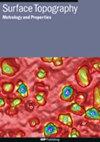Research on microstructure evolution and surface quality of WEDM for magnetic refrigerant rare-earth gadolinium
IF 2
3区 材料科学
Q2 ENGINEERING, MECHANICAL
引用次数: 0
Abstract
Rare-earth gadolinium (Gd) is preferable for manufacturing regenerators of the core components of room-temperature magnetic refrigeration owing to its unique magnetocaloric and mechanical properties. However, the surface quality of the regenerator plays a crucial role in the heat transfer effect and service life of magnetocaloric systems during wire electrical discharge machining (WEDM) when fabricating rare-earth Gd array microstructure regenerators. In this study, different process parameters were used to conduct a process experiment of the WEDM of rare-earth Gd. First, the evolution of the surface microstructure and its causes were analyzed using a single-factor experiment, while a corrosion test was conducted on the samples. The analysis showed that the pulse-on time and open voltage considerably affected the surface quality of the processed samples, while the samples with better surfaces exhibited good corrosion resistance. Additionally, a Taguchi experiment was designed, and a regression analysis used to establish regression models between the process parameters (pulse-on time, pulse-off time, peak current, open voltage, and water pressure) and both surface roughness (SR) and material removal rate (MRR). The results showed that the average prediction errors of SR and MRR were only 5.34% and 5.48%, respectively.磁性制冷剂稀土钆的线切割微结构演变和表面质量研究
稀土钆(Gd)具有独特的磁致性和机械性能,因此是制造室温磁制冷核心部件再生器的首选材料。然而,在制造稀土钆阵列微结构再生器时,再生器的表面质量在线切割加工(WEDM)过程中对磁致冷系统的传热效果和使用寿命起着至关重要的作用。本研究采用不同的工艺参数对稀土钆进行了线切割加工工艺实验。首先,利用单因素实验分析了表面微观结构的演变及其原因,同时对样品进行了腐蚀测试。分析表明,脉冲开启时间和开启电压对加工样品的表面质量有很大影响,而表面质量较好的样品具有良好的耐腐蚀性。此外,还设计了一个田口实验,并利用回归分析建立了工艺参数(脉冲开启时间、脉冲关闭时间、峰值电流、开启电压和水压)与表面粗糙度(SR)和材料去除率(MRR)之间的回归模型。结果表明,SR 和 MRR 的平均预测误差分别仅为 5.34% 和 5.48%。
本文章由计算机程序翻译,如有差异,请以英文原文为准。
求助全文
约1分钟内获得全文
求助全文
来源期刊

Surface Topography: Metrology and Properties
Materials Science-Materials Chemistry
CiteScore
4.10
自引率
22.20%
发文量
183
期刊介绍:
An international forum for academics, industrialists and engineers to publish the latest research in surface topography measurement and characterisation, instrumentation development and the properties of surfaces.
 求助内容:
求助内容: 应助结果提醒方式:
应助结果提醒方式:


